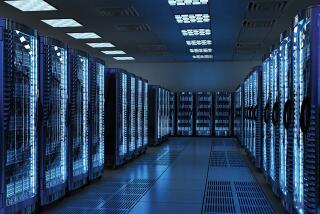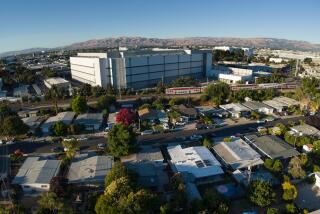Power, and pitfalls, of a ‘smart grid’
- Share via
WASHINGTON — One warm August afternoon in 2003, a power failure originating in Ohio coursed through the electrical grid in the Northeast, sparking the nation’s largest blackout and leaving millions in eight states without air conditioning, traffic lights and cellphone service.
Energy experts say that shutdown, which cost an estimated $6 billion, might have been averted by a “smart grid.”
President Obama has made the smart grid a major plank of his “rebuilding America” plan, viewing it as a way not only to eliminate blackouts and power failures, but also to create jobs and cut greenhouse gas emissions that contribute to global warming.
A smart grid -- a digital network enabling utilities, consumers and alternative sources of renewable energy to “talk” to one another instantaneously -- could steer electricity to where it is needed most.
In the economic stimulus act that the president signed in February, Congress allocated $4.5 billion for smart grid investments, a thin slice of the $38.7 billion that the package funneled to the Department of Energy.
But is it enough?
“We are making a down payment,” said Matt Rogers, a senior advisor to Energy Secretary Steven Chu.
The down payment will fund a set of pilot projects to demonstrate the viability of the smart grid and to show that it can deliver energy on a large scale, Rogers said.
Another goal: driving electrical utilities to make long-term investments in smart-grid technologies.
The Electric Power Research Institute, a utility industry think tank, has estimated the cost of building a smart grid at a staggering $165 billion -- about $8 billion a year for two decades.
And one of the biggest challenges in rolling out a smart grid, energy experts say, is getting hundreds of industries, from power generators to appliance and auto manufacturers, to agree on a set of standards -- some already developed, many not ready yet.
“If you look at how vast the grid is, all the way from generator to consumer, to bring together a communication fabric so that information can be exchanged will take four to five years, easy,” said Arshad Mansoor, vice president of power delivery and utilization at the institute.
Hired by the National Institute of Standards and Technology, a nonregulatory agency within the Department of Commerce, to develop a road map of standards and find consensus on a plan, Mansoor’s group will help NIST, Chu and Commerce Secretary Gary Locke jump-start the process in early May.
The potential problems are daunting: “It will be a mess,” Mansoor says, if auto manufacturers each come up with a unique standard for how plug-in hybrid technology will communicate with the smart grid. To avoid that scenario, the electric utility industry is working with automotive engineers to develop plug-in standards.
Demand for electricity is predicted to grow 30% by 2020, placing yet more stress on the grid and increasing risk of blackouts. That’s without the additional demand of 1 million plug-in hybrids that Obama has pledged to add to the nation’s roads by 2015.
“Today an American consumer uses 13 times the electricity he or she did a half-century ago, and there are twice as many of us,” James Hoecker told a House energy subcommittee this year. The former chairman of the Federal Energy Regulatory Commission, now counsel for electricity industry advocacy group WIRES, said: “We’re asking the transmission system to perform tasks for which it was not designed.”
Today, on hot summer days when consumers crank up the air conditioning, electric utilities have no way of controlling that demand. All they can do is turn on more power plants to try to meet it.
Bracken Hendricks, a senior fellow at the Center for American Progress, says that the “dumb and old energy distribution system” hasn’t changed much from the pioneering days of Thomas Edison and Nikola Tesla at the turn of 20th century.
“Electricity in the grid is like water in pipes,” Hendricks said. “You need to manage supply and demand. You have to keep the levels in balance or the whole system crashes down.”
In order to meet rising demand, he says, energy companies just build more power plants -- primarily fueled by coal or natural gas, a major source of carbon dioxide emissions.
Spreading a small measure of renewable energy around even a portion of the grid, Hendricks said, could prevent a cascading blackout like the one in 2003.
“We’re looking at a period that has all the potential to be very transformative, depending on how lean and mean the electricity industry can be,” Hoecker said in an interview. “It’s a quarter-century-long sustained effort.”
--
More to Read
Inside the business of entertainment
The Wide Shot brings you news, analysis and insights on everything from streaming wars to production — and what it all means for the future.
You may occasionally receive promotional content from the Los Angeles Times.










